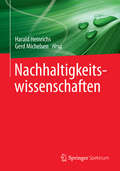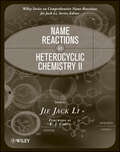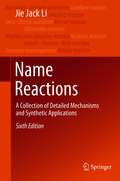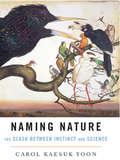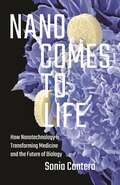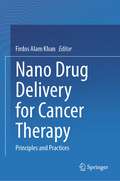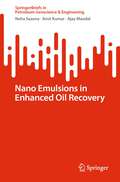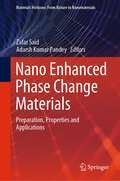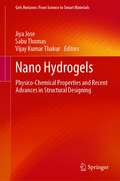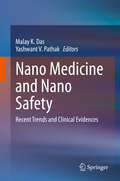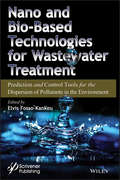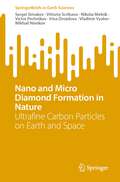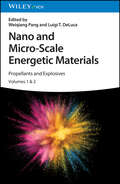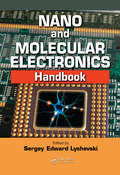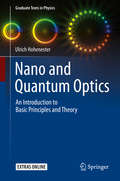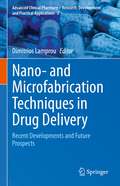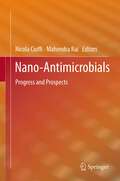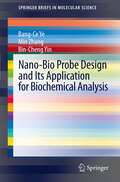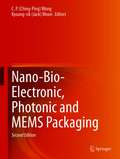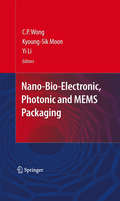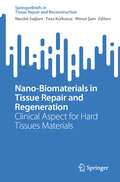- Table View
- List View
Nachhaltigkeitsmanagement im Gesundheitsbetrieb: Umsetzungsreife Konzepte für Klima- und Umweltschutz in Gesundheitseinrichtungen
by Andreas FrodlGesundheitsbetriebe sind gleichzeitig Betroffene und Mitverursachende des Klimawandels: Sie müssen Patient*innen, Bewohner*innen und Mitarbeitende vor dessen Auswirkungen schützen und gleichzeitig ihren Beitrag zum Umweltschutz leisten. Dieser Komplexität tragen die acht Leitfragen und daraus abgeleiteten Kapitel dieses Buches Rechnung.Als umfassende Anleitung zur Implementierung von Nachhaltigkeitsmanagement in Gesundheitseinrichtungen zeigt es, wie Klima- und Umweltschutz effektiv integriert werden können. Es behandelt die Herausforderungen und Chancen, Gesundheitsbetriebe nachhaltig auszurichten und bietet praxisnahe Lösungen zur Umsetzung. Zahlreiche Beispiele, Tabellen und Grafiken sowie konkrete Handlungsanleitungen und ein Glossar veranschaulichen und unterstützen diesen Ansatz.Für Führungskräfte, Nachhaltigkeitsbeauftragte und Entscheidungstragende im Gesundheitswesen, für Wissenschaftler*innen und alle, die die Zukunftsfähigkeit ihrer Einrichtungen nachhaltig sichern wollen.
Nachhaltigkeitswissenschaften
by Harald Heinrichs and Gerd MichelsenForscher und Dozenten der ersten deutschen Fakultät für Nachhaltigkeitswissenschaften an der Universität Lüneburg haben das Standardwerk zum Thema geschrieben. Sie schildern zunächst die naturwissenschaftlich-technischen Grundlagen, um anschließend die Perspektive der Akteure und integrierende Ansätze darzustellen. Zuletzt werden beispielhaft Problem- und Handlungsfelder wie Biodiversität und globale Gerechtigkeit aufgezeigt. Mit Infokästen, illustrativen Fallbeispielen sowie Hinweisen zu weiterführender Literatur und relevanten Institutionen.
Name Reactions in Heterocyclic Chemistry II (Comprehensive Name Reactions #6)
by Jie Jack LiThe up-to-DATE guide to name reactions in heterocyclic chemistry Name Reactions in Heterocyclic Chemistry II presents a comprehensive treatise on name reactions in heterocyclic chemistry, one of the most exciting—and important—fields within organic chemistry today. The book not only covers fresh ground, but also provides extensive information on new and/or expanded reactions in: Three- and four-membered heterocycles Five-membered heterocycles (pyrroles and pyrrolidines, indoles, furans, thiophenes, and oxazoles) Six-membered heterocycles, including pyridines, quinolines, and isoquinolines Featuring contributions from the leading authorities in heterocyclic chemistry. Each section includes a description of the given reaction, as well as the relevant historical perspective, mechanism, variations and improvements, synthetic utilities, experimental details, and references to the current primary literature. The reactions covered in Name Reactions in Heterocyclic Chemistry have been widely adopted in all areas of organic synthesis, from the medicinal/pharmaceutical field, to agriculture, to fine chemicals, and the book brings the most cutting-edge knowledge to practicing synthetic chemists and students, along with the tools needed to synthesize new and useful molecules.
Name Reactions: A Collection of Detailed Mechanisms and Synthetic Applications (Comprehensive Name Reactions Ser. #5)
by Jie Jack LiIn this sixth edition of Jack Jie Li's seminal "Name Reactions", the author has added three or more synthetic applications of name reactions to reflect the recent advances in organic chemistry. As in previous editions, each reaction is delineated by its detailed step-by-step, electron-pushing mechanism and supplemented with the original and the latest references, especially from review articles. This book is not only an indispensable resource for advanced undergraduate and graduate students for learning and preparing exams, but is also a good reference book for all organic chemists in both industry and academia. Unlike other books on name reactions in organic chemistry, Name Reactions, A Collection of Detailed Reaction Mechanisms and Synthetic Applications focuses on the reaction mechanisms. It covers over 300 classical as well as contemporary name reactions.
Naming Nature: The Clash Between Instinct and Science
by Carol Kaesuk YoonFinalist for the 2009 Los Angeles Times Book Prize in Science and Technology: the surprising, untold story about the poetic and deeply human (cognitive) capacity to name the natural world. Two hundred and fifty years ago, the Swedish botanist Carl Linnaeus set out to order and name the entire living world and ended up founding a science: the field of scientific classification, or taxonomy. Yet, in spite of Linnaeus's pioneering work and the genius of those who followed him, from Darwin to E. O. Wilson, taxonomy went from being revered as one of the most significant of intellectual pursuits to being largely ignored. Today, taxonomy is viewed by many as an outdated field, one nearly irrelevant to the rest of science and of even less interest to the rest of the world. Now, as Carol Kaesuk Yoon, biologist and longtime science writer for the New York Times, reminds us in Naming Nature, taxonomy is critically important, because it turns out to be much more than mere science. It is also the latest incarnation of a long-unrecognized human practice that has gone on across the globe, in every culture, in every language since before time: the deeply human act of ordering and naming the living world. In Naming Nature, Yoon takes us on a guided tour of science's brilliant, if sometimes misguided, attempts to order and name the overwhelming diversity of earth's living things. We follow a trail of scattered clues that reveals taxonomy's real origins in humanity's distant past. Yoon's journey brings us from New Guinea tribesmen who call a giant bird a mammal to the trials and tribulations of patients with a curious form of brain damage that causes them to be unable to distinguish among living things. Finally, Yoon shows us how the reclaiming of taxonomy--a renewed interest in learning the kinds and names of things around us--will rekindle humanity's dwindling connection with wild nature. Naming Nature has much to tell us, not only about how scientists create a science but also about how the progress of science can alter the expression of our own human nature.
Nanise', A Navajo Herbal: One Hundred Plants from the Navajo Reservation
by Vernon O. Mayes Barbara Bayless LacyNanise', A Navajo Herbal, co-authored by Vernon O. Mayes and Barbara Bayless Lacy, details 100 plants that are found on the Navajo Reservation, providing the reader with the Navajo name for each plant as well as ways the Navajos used them in everyday life, whether for ceremonial, medicinal or household purposes - complete with illustrations. The 100 plants are some of the most common Reservation flora of over 1,500 species of wild, vascular plants, including ferns, horsetails, conifers and flowering species and were selected by the Navajo Health Authority, Ethnobotany Project staff and approved by the Navajo Medicine Men's Association.
Nano Comes to Life: How Nanotechnology Is Transforming Medicine and the Future of Biology
by Sonia ConteraThe nanotechnology revolution that will transform human health and longevityNano Comes to Life opens a window onto the nanoscale—the infinitesimal realm of proteins and DNA where physics and cellular and molecular biology meet—and introduces readers to the rapidly evolving nanotechnologies that are allowing us to manipulate the very building blocks of life. Sonia Contera gives an insider's perspective on this new frontier, revealing how nanotechnology enables a new kind of multidisciplinary science that is poised to give us control over our own biology, our health, and our lives.Drawing on her perspective as one of today's leading researchers in the field, Contera describes the exciting ways in which nanotechnology makes it possible to understand, interact with, and manipulate biology—such as by designing and building artificial structures and even machines at the nanoscale using DNA, proteins, and other biological molecules as materials. In turn, nanotechnology is revolutionizing medicine in ways that will have profound effects on our health and longevity, from nanoscale machines that can target individual cancer cells and deliver drugs more effectively, to nanoantibiotics that can fight resistant bacteria, to the engineering of tissues and organs for research, drug discovery, and transplantation.The future will bring about the continued fusion of nanotechnology with biology, physics, medicine, and cutting-edge fields like robotics and artificial intelligence, ushering us into a new "transmaterial era." As we contemplate the power, advantages, and risks of accessing and manipulating our own biology, Contera offers insight and hope that we may all share in the benefits of this revolutionary research.
Nano Drug Delivery for Cancer Therapy: Principles and Practices
by Firdos Alam KhanThis book discusses the various modes and methods of nano-based drug delivery in different types of cancers such as colon, breast, cervical, ovarian, and lung cancer. It reviews the significance of nano drug delivery in cancer therapy, the application of nanoparticles in overcoming drug resistance, targeted therapy, and immunotherapy. The book also covers topics related to the synthesis of different types, shapes, and sizes of nanocarriers using synthetic and biological approaches. Further, a chapter explores the synthesis of nanocarriers loaded with anti-cancer drugs by using functionalization or conjugations and encapsulation methods. The book also examines the nanocarriers as delivery vehicles for chemotherapeutic agents against cancers using in vitro and animal models of cancers, preclinical trials for efficacy, and safety profiling of nanocarriers. Finally, future trends and innovation in nano drug delivery for cancer therapy, application of siRNA (nanoparticle-based RNA) therapy, ultrasound-linked nano-cancer therapeutics, and application of exosome-based cancer therapy topics are discussed. Towards the end, the book examines the limitations of nanocarriers, including the cell and tissue toxicity, genotoxicity, and scale-up of nanomaterials, health and environmental hazards associated with nanoformulation synthesis, respiratory diseases, government regulations, and ethical issues.
Nano Emulsions in Enhanced Oil Recovery (SpringerBriefs in Petroleum Geoscience & Engineering)
by Amit Kumar Neha Saxena Ajay MandalThis book focuses on the use of nanoemulsion in enhanced oil recovery, along with a brief information about the emulsion and its types and different physico-chemical properties used to analyse the efficiency of the emulsions and nanoemulsions. The author discussed about the nanoemulsion, classification of emulsions and nanoemulsion and use of nanoemulsions in petroleum industry. A special attention has been laid on nanoemulsion and its advantages over commercial product, physico-chemical properties like emulsification, interfacial tension and wettability alteration study as a screening criteria for application in EOR. Given this content, this book offers an assessment for the undergraduate and postgraduate students of petroleum and chemical engineering along with the researchers working in the field of EOR. It is a subject of interest for oil and gas industry professionals.
Nano Enhanced Phase Change Materials: Preparation, Properties and Applications (Materials Horizons: From Nature to Nanomaterials)
by Adarsh Kumar Pandey Zafar SaidThis book provides information on thermal energy storage systems incorporating phase change materials (PCMs) which are widely preferred owing to their immense energy storage capacity. The thermal energy storage (TES) potential of PCMs has been deeply explored for a wide range of applications, including solar/electrothermal energy storage, waste heat storage, and utilization, building energy-saving, and thermal regulations. The inherent shortcomings like leakage during phase transition and poor thermal conductivity hamper their extensive usage. Nevertheless, it has been addressed by their shape stabilization with porous materials and dispersing highly conductive nanoparticles. Nanoparticles suspended in traditional phase change materials enhance the thermal conductivity. The addition of these nanoparticles to the conventional PCM enhances the storage. In this book, the history of Nano Enhanced Phase Change Materials (NEPCM), preparation techniques, properties, theoretical modeling and correlations, and the effect of all these factors on the potential applications such as: solar energy, electronics cooling, heat exchangers, building, battery thermal management, thermal energy storage are discussed in detail. Future challenges and future work scope have been included. The information from this book can enable the readers to come up with novel techniques, resolve existing research limitations, and come up with novel NEPCM, that can be implemented for various applications.
Nano Hydrogels: Physico-Chemical Properties and Recent Advances in Structural Designing (Gels Horizons: From Science to Smart Materials)
by Sabu Thomas Vijay Kumar Thakur Jiya JoseThis book introduces the reader to important aspects of the nano-hydrogels. It covers the development of hydrogels and their biology, chemistry and properties. Focus is also given to innovative characterization techniques and advances in structural design, with special emphasis on molecular structure, dynamic behavior and structural modifications of hydrogels. This book serves as a consolidated reference work for the diverse aspects of hydrogels, creating a valuable resource for students and researchers in academia and industry.
Nano Medicine and Nano Safety: Recent Trends and Clinical Evidences
by Malay K. Das Yashwant V. PathakThis book reviews the application of Nanobiotechnology in the development of Nanomedicine, while also discussing the latest trends and challenges in the clinical translation of Nanomedicine. Nanomedicine refers to the application of Nanotechnology to medicine and holds tremendous potential for achieving improved efficiency, bioavailability, dose response, personalized medicine and enhanced safety as compared to conventional medicines.The book first introduces readers to the basic concepts of Nanomedicine, and to technological advances in and applications of Nanotechnology in treatment, diagnosis, monitoring, and drug delivery. In turn, it reviews the current status of multi-functionalization strategies for using Nanoparticles in the targeted delivery of therapeutic agents. The book’s third and final section focuses on the regulatory and safety challenges posed by Nanomedicine, including industry and regulatory agencies’ efforts to address them.
Nano Metal Oxides: Engineering and Biomedical Applications
by B. Karthikeyan G. Gnanakumar A. Therasa AlphonsaThis book highlights theoretical and experimental facts about selective nano-metal oxides. TiO2 ,ZnO and transition metal oxides which are known to be semiconductors and find applications in various fields. This book presents about recent findings like photo catalysis, sensing ,coating and biomedical applications. Therapeutic and future applications that are recently been reported of various metal oxides are presented in this book.
Nano and Bio-Based Technologies for Wastewater Treatment: Prediction and Control Tools for the Dispersion of Pollutants in the Environment
by Elvis Fosso-KankeuOver the past few decades the boom in the industrial sector has contributed to the release in the environment of pollutants that have no regulatory status and which may have significant impact on the health of animals and humans. These pollutants also refer as “emerging pollutants” are mostly aromatic compounds which derive from excretion of pharmaceutical, industrial effluents and municipal discharge. Some form of pollutions have also evolved, including the proliferation of acid mine drainage from oxidation or weathering of obsolete and unmanaged excavations around the world; this results mostly in the dispersion of inorganic pollutants in the environment at level surpassing the treatment capacity of conventional techniques. It is recurrent these days to find water treatment plants which no longer produce water that fits the purpose of domestic consumption based on newly established guidelines. This situation has prompted water authorities and researchers to develop tools for proper prediction and control of the dispersion of pollutants in the environment to ensure that appropriate measures are taken to prevent the occurrence of outbreaks due to sudden load of these pollutants in the water system. The chapters in this book cover a wide range of nano and bio-based techniques that have been designed for the real time detection of emerging contaminants in environmental water sources, geochemical models that are continuously improved for the prediction of inorganic contaminants migration from the mine solid wastes into ground and surface waters. Remediation strategies are also discussed and include effective techniques based on nanotechnology, advanced membrane filtration, oxidative and bio- degradation processes using various types of nanocatalysts, biocatalysts or supporting polymer matrices which are under advanced investigations for their implementation at large scale for the removal of recalcitrant pollutants from polluted water.This book is divided is two sections, the first section covers the occurrence of emerging pollutants in environmental water while the second section covers state of the art research on the removal of emerging pollutants from water using sustainable technologies. A total of 13 chapters addressing various topics related to the two sections are essentially based on recent development in the respective field which could have a significant impact on the enhancement of the performance of wastewater treatment plants around the world and especially in developing countries where access to clean and safe water remains a daily challenge
Nano and Micro Diamond Formation in Nature: Ultrafine Carbon Particles on Earth and Space (SpringerBriefs in Earth Sciences)
by Sergei Simakov Vittorio Scribano Nikolai Melnik Victor Pechnikov Irina Drozdova Vladimir Vyalov Mikhail NovikovIn this book, readers will gain a deep understanding of the distinct characteristics and intricate formation mechanisms behind each type of diamond.A standout feature of this book is its in-depth exploration of nanodiamonds, shedding light on their unique formation processes. The narrative is thoughtfully organized, covering four main categories of natural diamonds and their related formation processes: 1)Interstellar nanodiamond particles; 2) Nano- and microcrustal diamonds associated with coals, sediments, and metamorphic rocks; 3) Nanodiamonds and microdiamonds associated with secondary alterations of mafic and ultramafic rocks mainly in the oceanic lithosphere; 4) Mantle-derived diamonds associated with kimberlites and their xenoliths, such as peridotites and eclogites.With clarity and precision, this book caters to both researchers and students in the fields of mineralogy and mineral formation. This book serves as an invaluable resource, offering an all-encompassing perspective on diamond formation, appealing to those curious minds eager to delve into the captivating realm of these precious gems.
Nano and Micro-Scale Energetic Materials: Propellants and Explosives
by Luigi T. DeLuca Weiqiang PangProvides an up-to-date account of innovative energetic materials and their potential applications in space propulsion and high explosives Most explosives and propellants currently use a small number of ingredients, such as TNT and nitrocellulose. In comparison to conventional materials, nano- and micro-scale energetic materials exhibit superior burning characteristics and much higher energy densities and explosive yields. Nano and Micro-scale Energetic Materials: Propellants and Explosives provides a timely overview of innovative nano-scale energetic materials (nEMs) and microscale energetic materials (µEMs) technology. Covering nEMs and µEMs ingredients as well as formulations, this comprehensive volume examines the preparation, characterization, ignition, combustion, and performance of energetic materials in various applications of propellants and explosives. Twenty-two chapters explore metal-based pyrotechnic nanocomposites, solid and hybrid rocket propulsion, solid fuels for in-space and power, the sensitivity and mechanical properties of explosives, new energetic materials, and more. Explores novel energetic materials and their potential for use in propellants and explosives Summarizes the most recent advances of leading research groups currently active in twelve countries Discusses how new environmentally friendly, high-combustion energetic materials can best be used in different applications Explains the fundamentals of energetic materials, including similarities and differences between composite propellants and explosives Nano and Micro-scale Energetic Materials: Propellants and Explosives is an important resource for materials scientists, explosives specialists, pyrotechnicians, environmental chemists, polymer chemists, physical chemists, aerospace physicians, and aerospace engineers working in both academia and industry.
Nano and Molecular Electronics Handbook (Nano and Microengineering Series)
by Sergey Edward LyshevskiThere are fundamental and technological limits of conventional microfabrication and microelectronics. Scaling down conventional devices and attempts to develop novel topologies and architectures will soon be ineffective or unachievable at the device and system levels to ensure desired performance. Forward-looking experts continue to search for new paradigms to carry the field beyond the age of microelectronics, and molecular electronics is one of the most promising candidates. The Nano and Molecular Electronics Handbook surveys the current state of this exciting, emerging field and looks toward future developments and opportunities.Molecular and Nano Electronics ExplainedExplore the fundamentals of device physics, synthesis, and design of molecular processing platforms and molecular integrated circuits within three-dimensional topologies, organizations, and architectures as well as bottom-up fabrication utilizing quantum effects and unique phenomena.Technology in ProgressStay current with the latest results and practical solutions realized for nanoscale and molecular electronics as well as biomolecular electronics and memories. Learn design concepts, device-level modeling, simulation methods, and fabrication technologies used for today's applications and beyond.Reports from the Front Lines of ResearchExpert innovators discuss the results of cutting-edge research and provide informed and insightful commentary on where this new paradigm will lead. The Nano and Molecular Electronics Handbook ranks among the most complete and authoritative guides to the past, present, and future of this revolutionary area of theory and technology.
Nano and Quantum Optics: An Introduction to Basic Principles and Theory (Graduate Texts in Physics)
by Ulrich HohenesterThis classroom-tested textbook is a modern primer on the rapidly developing field of quantum nano optics which investigates the optical properties of nanosized materials. The essentials of both classical and quantum optics are presented before embarking through a stimulating selection of further topics, such as various plasmonic phenomena, thermal effects, open quantum systems, and photon noise. Didactic and thorough in style, and requiring only basic knowledge of classical electrodynamics, the text provides all further physics background and additional mathematical and computational tools in a self-contained way. Numerous end-of-chapter exercises allow students to apply and test their understanding of the chapter topics and to refine their problem-solving techniques.
Nano- and Microfabrication Techniques in Drug Delivery: Recent Developments and Future Prospects (Advanced Clinical Pharmacy - Research, Development and Practical Applications #2)
by Dimitrios LamprouNew materials and manufacturing techniques are evolving with the potential to address the challenges associated with the manufacture of medicinal products that will teach new tricks to old drugs. Nano- and microfabrication techniques include manufacturing methods such as additive manufacturing, lithography, micro-moulding, spray drying, and supercritical fluids among many others. The increasing resolution of new techniques allow researchers to produce objects with micrometric resolutions. This book follows a consecutive order, beginning with a background in the current field and limitations in the manufacturing of different pharmaceutical products, moving on the classification of each method by providing recent examples, and future prospective on a variety of traditional and new Nano and microfabrication techniques. A focus on the materials used to prepare these systems and their biocompatibility, including applied topics such as clinical applications and regulatory aspects also covered, offering the reader a holistic view of this rapidly growing field.
Nano-Antimicrobials
by Mahendra Rai Nicola CioffiThere is a high demand for antimicrobials for the treatment of new and emerging microbial diseases. In particular, microbes developing multidrug resistance have created a pressing need to search for a new generation of antimicrobial agents, which are effective, safe and can be used for the cure of multidrug-resistant microbial infections. Nano-antimicrobials offer effective solutions for these challenges; the details of these new technologies are presented here. The book includes chapters by an international team of experts. Chemical, physical, electrochemical, photochemical and mechanical methods of synthesis are covered. Moreover, biological synthesis using microbes, an option that is both eco-friendly and economically viable, is presented. The antimicrobial potential of different nanoparticles is also covered, bioactivity mechanisms are elaborated on, and several applications are reviewed in separate sections. Lastly, the toxicology of nano-antimicrobials is briefly assessed.
Nano-Bio Probe Design and Its Application for Biochemical Analysis
by Min Zhang Bin-Cheng Yin Bang-Ce YeIn this volume, Prof. Ye and his coworkers propose and review the concept of nano-bio probe design for biochemical analysis on the basis of their recent published works. A unique biochemical analysis technology based on fluorescence polarization enhanced by nanoparticles is described here with successful applications in environmental monitoring, rapid and sensitive sensing protease activity and high-throughput screening of inhibitors. Furthermore, they introduce a versatile molecular beacon (MB)-like probe for the multiplex sensing of targets such as sequence-specific DNA, protein, metal ions and small molecule compounds based on the self-assembled biomolecule-graphene conjugates. Besides, some colorimetric and luminescence probes utilizing metal nanoparticles for biochemical applications are also presented, such as chiral enantiomer discrimination and separation, environmental monitoring, clinic diagnosis and etc.
Nano-Bio- Electronic, Photonic and MEMS Packaging
by Yi Li Kyoung-Sik Jack Moon C. P. Ching-Ping WongThis book shows how nanofabrication techniques and nanomaterials can be used to customize packaging for nano devices with applications to electronics, photonics, biological and biomedical research and products. It covers topics such as bio sensing electronics, bio device packaging, MEMS for bio devices and much more, including:Offers a comprehensive overview of nano and bio packaging and their materials based on their chemical and physical sciences and mechanical, electrical and material engineering perspectives;Discusses nano materials as power energy sources, computational analyses of nano materials including molecular dynamic (MD) simulations and DFT calculations;Analyzes nanotubes, superhydrophobic self-clean Lotus surfaces;Covers nano chemistry for bio sensor/bio material device packaging.This second edition includes new chapters on soft materials-enabled packaging for stretchable and wearable electronics, state of the art miniaturization for active implantable medical devices, recent LED packaging and progress, nanomaterials for recent energy storage devices such as lithium ion batteries and supercapacitors and their packaging. Nano- Bio- Electronic, Photonic and MEMS Packaging is the ideal book for all biomedical engineers, industrial electronics packaging engineers, and those engaged in bio nanotechnology applications research.
Nano-Bio- Electronic, Photonic and MEMS Packaging
by C. P. Wong Yi Grace Li Kyoung-Sik MoonNanotechnologies are being applied to the biotechnology area, especially in the area of nano material synthesis. Until recently, there has been little research into how to implement nano/bio materials into the device level. "Nano and Bio Electronics Packaging" discusses how nanofabrication techniques can be used to customize packaging for nano devices with applications to biological and biomedical research and products. Covering such topics as nano bio sensing electronics, bio device packaging, NEMs for Bio Devices and much more.
Nano-Biofortification for Human and Environmental Health (Sustainable Plant Nutrition in a Changing World)
by Hassan El-Ramady Vishnu D. Rajput Tatiana Minkina Sudhir K. Upadhyay Bilal Ahmed Saglara MandzhievaNanotechnology has shown great potential to alleviate increasing pressure to meet food needs for our increasing human population, Novel agricultural innovations are required to enhance the health of edible crops and per unit area yield without impacting the associated environment in a negative way. Recent advancements in nanotechnology-based agricultural solutions have proven to help overcome the problems in agriculture that are associated with run-off of essential fertilizers from agricultural soils, low nutrient accumulation by crops, as well as to control insects, pests, and seasonal biotic factors, treatment of wastewater used for irrigation, plant uptake of xenobiotics (heavy metals, pesticides, industrial chemicals, drugs, and so on) that may be present in contaminated soils. Additionally, the consumption of such food crops may result in malnourishment and plant-mediated transfer of toxic substances among humans especially in underprivileged and rural populations. Agents to stimulate plant growth include various types of nanomaterials such as carbon nanotubes, metal, and metal-oxide nanoparticles. Applications of particular nutrients or elements in crop plants can be shown to aid human nourishment (either by directly inducing its uptake or indirectly through enhancing the intracellular levels of other associated elements that ultimately boost the synthesis of the desired nutrient in plants). It is also important to consider the competence and fate of nanomaterials in soil ecosystems. The entry route of nanomaterials into the environment includes both natural and anthropogenic sources. In order to achieve sustainable and safe use of nanotechnological products in agriculture, similar environmental conditions must be simulated on lab scale with the careful selection of organisms related to agriculture. Thus, emphasis should be placed on the judicial use of nano-enabled products without compromising the sustainability of the environment and human health. This comprehensive book highlights recent field research as well as contributions from academicians in the lab. This book addresses the major aspects related to nanotechnology, biofortification of crops, and human and environmental health.
Nano-Biomaterials in Tissue Repair and Regeneration: Clinical Aspect for Hard Tissues Materials (Tissue Repair and Reconstruction)
by Feza Korkusuz Necdet Sağlam Mesut ŞamThis book covers the clinical application of nano-biomaterials in hard tissue repair and regeneration which are materials designed to interact with biological systems to restore and regenerate damaged tissues. These materials serve as scaffolds that mimic the natural extracellular matrix (ECM), providing structural support and biochemical cues necessary for cellular activities. The physical and chemical properties of biomaterials can be tailored to specific applications, such as bone regeneration, cartilage repair, wound healing, and organ transplantation. Biomaterials influence cell behavior and tissue formation by controlling factors like mechanical strength, porosity, and surface topography. This book is suitable to students, academics, and clinical practitioners who are interested in the advancements of regenerative medicine.

